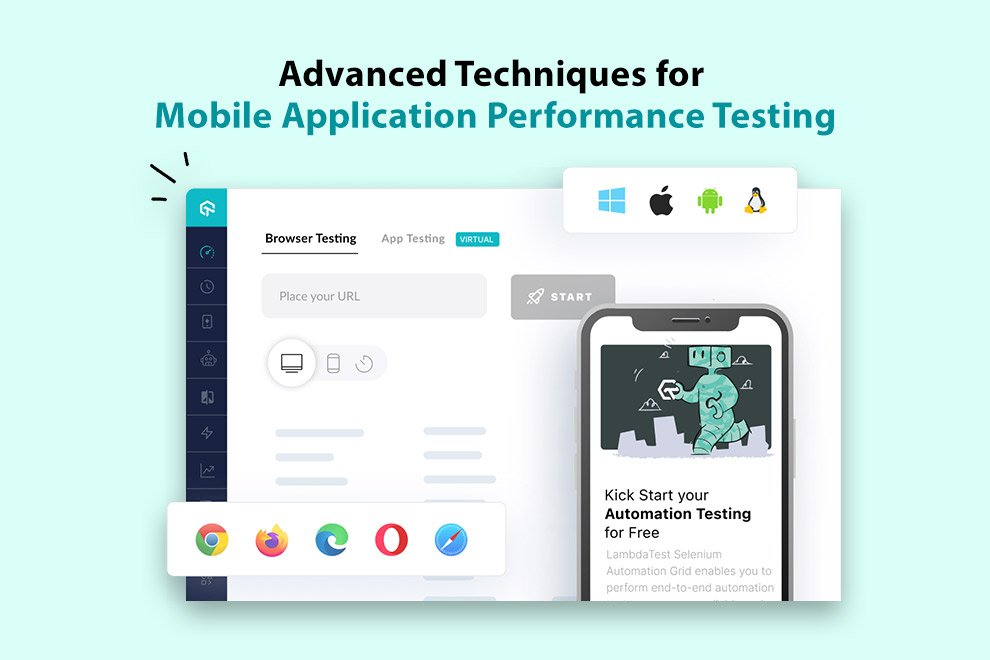Can you guess the total traffic coming from mobile devices in the current generation? Be prepared! More than 55% of Internet users come from mobile devices like smartphones and tablets. This clearly shows that we are slowly moving towards an app development industry that will be completely mobile-first in terms of architecture and design. However, to deal with modern app complexities, you need to use advanced features like AI for software testing.
If your app does not provide the required responsiveness, speed, and resource usage on mobile devices, you can risk gathering a lot of negative reviews, which will massively impact your brand reputation and your overall revenue in the long run.
Facing challenges with mobile application performance testing? Don’t worry! We are here for you. Our article will help you understand all the advanced practices that can help you in this process. We’ll also discuss some of the major tools and best practices that can help you streamline the entire workflow.
Why Mobile App Performance Matters
Before we start discussing all the required details, you must have a question in the back of your head about what are the major reasons that justify investing so much time and resources in a mobile app development process. To help you with this knowledge, we have mentioned some of the major factors that justify the role of mobile app performance:
- Do you know that your users expect your mobile apps to load within 2 seconds? If you fail to provide such an experience, they will completely abandon your application with a vow to never return again.
- While providing the best user experience on mobile devices, you should also ensure that your application functions smoothly even under fluctuating bandwidth and changing demographic network requirements.
- It is also equally important to ensure that even after providing the best end-user experience, your application does not consume excessive battery or other mobile resources. If you fail to do so, the users will uninstall the application and look for an alternative in the market.
- In terms of business parameters, poor performance can discourage purchases, subscriptions, and can lead to customer churn. Moreover, if you have a lot of performance complaints and user feedbacks, you will have to invest additional operational costs to resolve them.
Therefore, by properly investing in advanced mobile performance testing, you can avoid all of the above bottlenecks to create high-end user satisfaction. Factors like these are very important to maintain your business value and also the brand loyalty as a whole.
Preparing Your Performance Testing Environment
To ensure that you are properly executing your advanced mobile performance test cases, you must properly prepare the environment and the test scenarios. To further help you with the preparation process, we have measured some of the most important factors that you must keep in mind during this step:
- Real Devices vs. Emulators/Simulators
To understand how your application performs when it is exposed to multiple real-world parameters, you must include real devices within your testing ecosystem. This is because although emulators and simulators are cost-effective, they cannot portray the change in app performance when exposed to various physical parameters like broken screens, low bandwidth, or user errors.
While integrating real device testing, you must also remember that real devices are expensive, and it can cost you millions of dollars to set up a bench of thousands of such devices. The most accurate alternative to this will be the inclusion of cloud-based platforms like LambdaTest.
- Network Conditions
Fluctuating networks are one of the most important signs of a mobile device. So, you should not test your application on only robust Wi-Fi networks as it will mask issues that will arise on poor or inconsistent conditions.
Therefore, we suggest the testers to add various network conditions like 2G, 3G, Wi-Fi with different bandwidths, and offline or intermittent connections.
- Device Fragmentation
Do you know that more than 1000 new Android devices are released every year? It is needless to say that all of these devices are unique in terms of software and hardware parameters. Therefore, while choosing your target devices for performance testing, you should not restrict them to high-end latest devices.
It is also very important to remember that more than 75% of your users will not update their mobile devices before three years. Therefore, legacy or automated devices should be a very important part of your mobile test bench.
- Test Data Setup
Finally, you must remember that your performance tests should closely replicate various real-world data volumes like user profiles, media content, and data caches. This is because if you execute the testing processes with only trivial or minimal data, it will not reveal the bottlenecks that can arise when the application is exposed to the real-world load.
Some of the most important factors that you must consider in this step include thousands of records, large image assets, or working on a complex user data set.
Advanced Techniques for Mobile Performance Testing
Apart from the basic practices, let us go through some of the advanced techniques that can help further elevate the quality of your mobile performance test cases:
Test Automation and Continuous Integration/Continuous Delivery
We suggest the testers to initiate performance testing with continuous integration and continuous delivery pipelines to ensure that you are running the test cases after every code commit or feature update.
You can use tools like Jenkins, GitLab CI, or GitHub Actions to automatically run the performance suites after every change within the application source code. You can also consider establishing thresholds for metrics like response time or CPU usage during the test execution process.
Network Virtualization and Throttling
You must understand that while functioning over a mobile network, you will encounter scenarios of unstable bandwidth or high latency. To ensure that the application can properly cope up with these circumstances, you must simulate various network conditions during the performance testing process.
You can use command-line tools like TC on Linux to introduce delays in network bandwidths. You can also rely on third-party services like Charles Proxy and Network Link Conditioner for initiating network throttling.
Stress and Spike Testing for Mobile APIs
If your app experiences certain search and user activity spikes, like during a promotional campaign or product launch, the back-end servers will get stressed. So, we suggest the testers to conduct stress testing and spike testing on the mobile application’s backend APIs to ensure scalability and recovery.
You can also consider using load testing tools like Gatling, Apache Jmeter, or Locust to simulate high traffic volumes and generate relevant testing data.
Cloud-Based Device Farms
While implementing mobile performance testing, you will require access to real device farms to understand how your application behaves when exposed to the physical parameters of a device.
If you are using an onsite device lab, it will not only be expensive and resource-intensive but will also be difficult to maintain and scale. To avoid such restrictions, you can consider using cloud-based device farms like AWS device farm or LambdaTest. To further understand the role of cloud-based device forms in this regard, let us use the example of LambdaTest:
LambdaTest is an AI-powered test orchestration and execution platform that lets you perform manual and automation testing at scale with over 3000+ real devices, browsers, and OS combinations. Apart from using LambdaTest to integrate AI in testing, you can also use it to monitor the test cases and generate comprehensive test reports after the execution phase.
Best Practices in Advanced Mobile Performance Testing
Finally, let us go through some of the best practices that we highly recommend the testers to incorporate within their advanced mobile performance testing infrastructure. These practices will be highly useful to improve the stability, scalability, and quality of the app infrastructure:
- You must add the performance testing scenario as early as possible to the development cycle, which is a part of the shift-left testing approach. By performing unit tests and code profiling in the early stages, you can find and fix performance issues before they can turn into serious concerns.
- A comprehensive testing strategy for app performance will include load and stress testing, soak testing, network and connectivity tests, along with compatibility checks. All these parameters have an equal role in ensuring that the application provides the desired performance when it is exposed to multiple unpredictable real-world parameters.
- As a tester, you must understand that not all features of your application are equally important. Therefore, you must find the core user journeys, like signups, checkouts, and content feed loading, which are important for the overall functioning of the app. These areas will be your primary focus while executing advanced performance testing.
- We recommend the testers to create benchmark values for metrics such as launch time or response time. For example, if your average response time is 200ms, you must create 300ms as your peak limit. Continuous monitoring will ensure that you never reach this upper limit.
- Your mobile app’s performance isn’t the responsibility of any single team. Developers, QA teams, DevOps teams, and product managers will have an equal share in creating and achieving the goals and data for mobile performance. Proper collaboration in this regard will also ensure that you get better insights about the application’s target audience and requirements.
- Finally, you should remember that as a performance tester your role does not end after the product release. You must track the performance in the production environment using real user monitoring and continuous APM solutions. It is very important for implementing iterative improvements and understanding how real customers experience your app.
The Bottom Line
Based on all the factors that we have put forward in this article, we can easily say that the performance of mobile applications is a make or break scenario for your business. A fast, stable, and resource-efficient mobile app will create positive user experiences, loyalty, and lead to revenue growth. On the other hand, poor performance in this regard can cause user frustration, uninstalls and a damaged brand reputation.
All the advanced techniques that we put forward in this article, along with the tools and best practices, will help address the key mobile performance issues and provide stability under real-world usage conditions.
Finally, you must remember that performance testing is not a one-off scenario, as you will have to constantly implement it with discovery, measurement, optimization, and validation throughout the evolution of the app. While incorporating advanced practices like AI for software testing, you must ensure that you’re still keeping the human touch that is very important in this entire flow.
Also Read: Mobile Application Performance Testing










